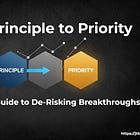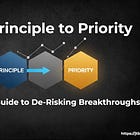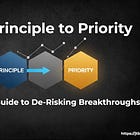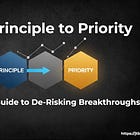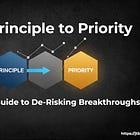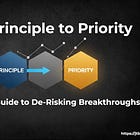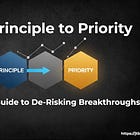From Principle to Priority: Chapter 4
The Human Element: Identifying the “Job Executor
This 10-article series is designed to disrupt common thinking about innovation. It provides a new framework to help you tear down old methods and invest more efficiently in breakthrough ideas. Please share!
In the previous chapter, we performed an act of intellectual demolition. We took the vague, analogy-driven problem of “managing carbon emissions” and, using the deconstructive force of First Principles, smashed it down to its fundamental truth. We discovered that the problem-as-is was a-symptom, a mask. The real problem, the First Principle, was: “Organizations need to neutralize quantified environmental liabilities through a verifiable transfer of economic value.”
This is a profound and clarifying breakthrough. We have escaped the gravity of the status quo. We are no longer anchored to the world of “better dashboards” or “more efficient reporting.” We have a new, fundamental insight that points toward an entirely different class of solution, one rooted in markets, assets, and financial integrity.
But this insight, as powerful as it is, remains abstract. A “liability” does not feel a struggle. A “transfer of value” does not have a budget.
Our First Principle is the “what.” We must now find the “who.”
This is the second, indispensable half of our “Option to Explore.” We must move from the abstract logic of the problem to the lived, human context in which it exists. This is where we integrate the second of our core methodologies: Jobs-to-be-Done (JTBD).
The core theory of JTBD is simple, but its implications are revolutionary. It posits that customers do not buy products or services. They “hire” them to get a “job” done. A “job,” in this framework, is a core, solution-agnostic, functional process that an individual is trying to execute in a specific context. For centuries, people have had the job of “listening to music away from the performers.” They have hired orchestras, gramophones, Walkmans, iPods, and now streaming services to get this job done. The job is stable; the solutions are what evolve.
Our mission at this stage is to identify the specific human being who is struggling to get the job done that our First Principle revealed.
This brings us to a critical distinction that derails most innovation efforts: the “Job Executor” versus “the Customer.”
In B2B innovation, teams are often told to focus on “the customer.” But who is that? Is it the procurement department that signs the check? The IT department that integrates the software? The end-user who touches the keyboard? The executive who sponsors the budget? “The customer” is a uselessly vague composite of a dozen different roles with competing, often contradictory, motivations.
A Job Executor, by contrast, is a precise, specific, and singular role. It is the person or title who is directly responsible for the execution and successful outcome of the core functional job.
Finding the correct Job Executor is the most critical strategic choice we will make. And this is where our First Principles deconstruction becomes our most powerful guide.
Let’s return to our carbon emissions case. Our First Principle is: “neutralizing a quantified financial liability.”
Who is the Job Executor?
Candidate 1: The Sustainability Manager (The “Analogy” Executor) If we had skipped the First Principles step and reasoned from analogy (”managing carbon emissions”), we would have immediately identified the ‘Sustainability Manager’ as our Job Executor. And what is their job? “Gathering data,” “Compiling reports,” “Ensuring compliance with reporting standards.” This is a real job, but it is a job of symptom management. This individual is trapped in the existing, broken solution. Innovating for them—building them a “better spreadsheet”—is the definition of incrementalism. We would be helping them get the wrong job done more efficiently.
Candidate 2: The Chief Financial Officer (The “First Principle” Executor) Our deconstruction revealed the problem is not about reporting; it’s about a financial liability. Who in the entire corporation is the Job Executor for mitigating financial liabilities? There is only one answer: the Chief Financial Officer (CFO).
This single pivot—from Sustainability Manager to CFO—changes the entire landscape. The Sustainability Manager is measured on the timeliness and accuracy of their report. The CFO is measured on protecting the balance sheet and maximizing shareholder value. The scale of the problem, the size of the budget, and the strategic importance of the solution have all increased by an order of magnitude.
The Sustainability Manager struggles with spreadsheets. The CFO struggles with unquantified, volatile, and massive new financial risks that threaten the company’s public valuation. This is the problem we want to solve.
By correctly identifying the Job Executor, we have aligned our innovation effort with a center of real, strategic, and budgetary power.
Now we must define their job with precision. The JTBD framework demands a specific syntax for defining a core functional job, designed to be solution-agnostic and stable:
[Verb (Gerund)] + [Object] + [Contextual Clarifier]
We must use an approved lexicon of verbs—strong, functional, and non-vague. We are forbidden from using words like “managing,” “handling,” or “facilitating,” as they are imprecise and hide the true objective.
So, what is the CFO’s core functional job?
Wrong (Vague): “Managing carbon risk.” (Uses a forbidden verb and is imprecise.)
Wrong (Solution-Specific): “Buying high-quality carbon offsets.” (This is one possible solution, not the job itself.)
Right (Core Functional Job): “Mitigating quantified environmental liabilities in a verifiable and auditable manner.”
This statement is our “Job-to-be-Done.” It is the human-centric expression of our First Principle. It is stable, precise, and entirely solution-agnostic. It does not hint at “software,” “marketplaces,” or “consulting.” It simply states the “who” (CFO) and the “what” (their core job) with exacting clarity.
But we are not finished. A human being is not a purely functional robot. When a Job Executor “hires” a new solution—a new product, process, or service—they are not just evaluating its functional performance. They are, consciously or not, evaluating it on two other critical dimensions: the social and the emotional.
1. The Functional Job: This is the practical, objective task we just defined.
“Mitigating quantified environmental liabilities in a verifiable and auditable manner.”
2. The Social Job: This relates to how the Job Executor wants to be perceived by others while executing the job. For a CFO, this is paramount.
“Be seen by the board of directors as a strategic, forward-looking leader who anticipates risk.”
“Demonstrate impeccable control and foresight to investors and market analysts.”
“Avoid being perceived by regulators as unprepared, reactive, or negligent.”
3. The Emotional Job: This relates to how the Job Executor wants to feel while executing the job. This is the internal, psychological driver.
“Feel confident and secure in the face of extreme regulatory and market volatility.”
“Feel a sense of control over a massive, ambiguous new variable.”
“Avoid the feeling of being blindsided, exposed, or at a disadvantage.”
These three dimensions—Functional, Social, and Emotional—are the “hiring criteria.” A new solution can be functionally perfect, but if it makes the CFO feel less in control (it’s an opaque “black box”) or makes them look foolish in a board meeting (it’s too complex to explain), it will be “fired.”
Conversely, a solution that not only mitigates the liability (functional), but also provides the data to make the CFO look like a strategic genius to investors (social) and gives them a feeling of total control over their risk exposure (emotional) will be “hired” and will command a premium price. These dimensions are not “soft” nice-to-haves; they are the primary drivers of adoption and value.
This completes our “Option to Explore.” We have paid our first, small premium. And look at what we have purchased for it.
We started with a vague, industry-wide hunch about “carbon management.”
Through a staged, systematic process, we have transformed that hunch into a high-resolution, de-risked innovation hypothesis:
The First Principle (The “What”): The core problem is not reporting, but neutralizing a quantified financial liability through a verifiable transfer of economic value.
The Job Executor (The “Who”): The Chief Financial Officer is the human being with the budget and responsibility for this problem.
The Core Job (The “Why”): Their motivation is functional (mitigate the liability), social (be seen as a strategic leader), and emotional (feel secure and in control).
We have not written a line of code. We have not designed a single screen. We have not built a five-year forecast. We have done something infinitely more valuable: we have defined the problem. We have found the right problem and the right person.
We now have a rock-solid, qualitative foundation. We have an insight. But an insight is not a business. We have a hypothesis, but we do not have evidence.
We have a strong reason to believe this is a real problem for some CFOs. But is it a big enough problem? Is it a frequent problem? Is it an underserved problem?
Our qualitative exploration is complete. We must now earn the right to our next investment: the Option to Validate. We must move from the qualitative to the quantitative, from the map to the market. We must find out exactly where, and how much, the CFO is struggling.
Guide to the Series
I make content like this for a reason. It’s not just to predict the future; it’s to show you how to think about it from first principles. The concepts in this blueprint are hypotheses—powerful starting points. But in the real world, I work with my clients to de-risk this process, turning big ideas into capital-efficient investment decisions, every single time.
Follow me on 𝕏: https://x.com/mikeboysen
If you’re interested in inventing the future as opposed to fiddling around the edges, feel free to contact me. My availability is limited.
Mike Boysen - www.pjtbd.com
De-Risk Your Next Big Idea
Masterclass: Heavily Discounted $67
My Blog: https://jtbd.one
Book an appointment: https://pjtbd.com/book-mike
Join our community: https://pjtbd.com/join



